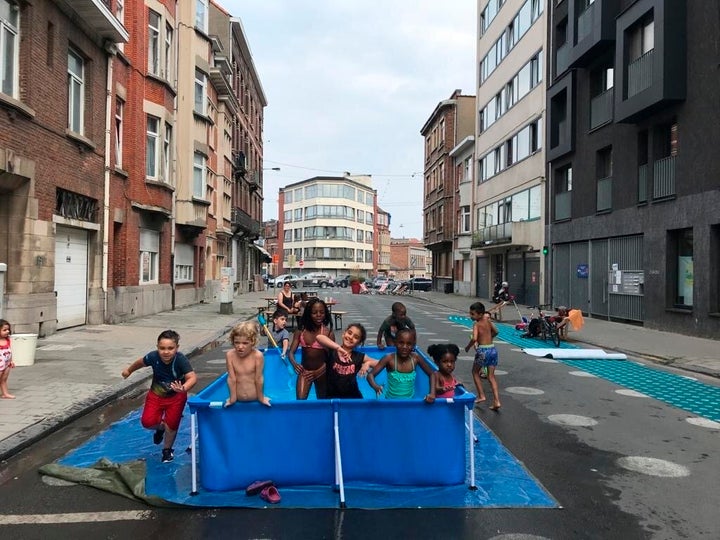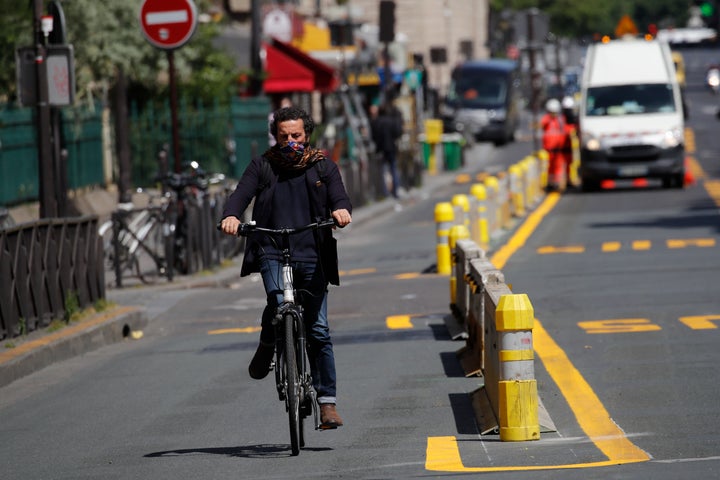The most famous advice in modern politics might be, “Never let a good crisis go to waste.”
In Europe, policymakers have seized on the coronavirus pandemic to re-envision how cities should look, feel and function. Milan has lowered speed limits, converted intersections into public space and declared the explicit goal of reducing car usage. The British government has committed to investing $2.6 billion in sustainable transportation infrastructure; London authorities are planning for a fivefold increase in walking and a tenfold increase in bicycling. Paris Mayor Anne Hidalgo announced a plan to install more than 400 miles of new bicycle lanes, many on the city’s busiest thoroughfares.
So far, American policymakers have shown noticeably less ambition. Despite the importance of open space for preventing the spread of COVID-19, the federal government has not announced any plans to increase spending on bicycle lanes or sidewalks.
Cities, too, have been reluctant to repurpose street space. Seattle, for example, was heralded for closing just 20 miles of low-traffic residential streets during lockdown. Los Angeles and New York have blocked off a tiny percentage of their road networks but have dragged their feet on making larger-scale, permanent fixes.
Danny Harris, the executive director of Transportation Alternatives, a nonprofit that advocates for walking, cycling and public transit infrastructure, said the reluctance of city leaders to reimagine public space represents a major missed opportunity.
“The streets could be a pathway to recovery,” Harris said. “They could move more people around with bike and bus lanes. They could become outdoor space for restaurants. They could help communities that are underserved by parks.”
But instead, cities are already returning to the pre-COVID status quo of snarled traffic, harmful air pollution and hostile public spaces. There’s a growing fear that budget cuts and fear of infection on public transport may shift commuters from buses and subways into single-passenger cars, and that the huge spike in demand for walking and biking may peter out if cities don’t expand cycle lanes or sidewalks.
“If even a small percentage of people who take the bus every day start driving, cities are going to shut down,” Harris said. “I understand why people want to go back to normal, but ‘normal’ means traffic and honking and pollution.”

Cities Need To Reduce Their Dependence On Cars
Reducing the number of cars on the road is good for the planet, good for cities and good for Americans. Transportation remains the United States’ No. 1 source of greenhouse gas emissions.
And roughly 36,000 Americans are killed every year in car crashes. At the same time, less than 5% of Americans report getting 30 minutes of exercise per day; roughly 40% say they haven’t spent more than 10 minutes walking in the past week.
Getting Americans out of their cars would reduce these problems, and could help city residents spread out to avoid contracting COVID-19. In April, the World Health Organization recommended walking or cycling “whenever feasible.”
Despite early warnings that citizens should avoid buses and subways during the coronavirus pandemic, public transit has not emerged as a source of spread. According to a study in Paris, only 1% of coronavirus clusters originated on public transport. Another, in Japan, found zero outbreaks linked to buses or trains. Public transit’s strong ventilation systems, combined with widespread mask usage and lack of conversation among travelers, appears to make it safer than it first appeared.
Pollution from cars, on the other hand, is a significant risk factor for COVID-19: In April, a Stanford study found that a relatively minor increase in long-term exposure to airborne pollutants was linked to an 8% higher COVID-19 death rate.
“In Europe, they’ve been thinking about how to deliver a car-free or car-lite experience for years.”
- Mike Lydon, co-founder of urban planning firm Street Plans
“We’re such an auto-dominated society that it’s hard to get people to see how important it is to reduce driving,” said Mike Lydon, the co-founder of an urban planning firm, Street Plans, that specializes in walking, biking and public transit infrastructure.
For progressive policymakers, Lydon said, the coronavirus lockdown was an unprecedented opportunity to lay the groundwork for more sustainable post-pandemic cities. Not only did lockdown orders empty streets, flush downtowns and pause public transport, but the pandemic gave mayors and governors wide-ranging emergency powers. They could have used their authority to install networks of bicycle lanes or dedicated bus infrastructure.
“Cities needed leadership and most places didn’t get it,” Lydon said. Recapturing streets for buses, bikes or open space doesn’t require copious amounts of money or time. Bus lanes can be striped with paint; bicycle lanes can be protected with makeshift barriers that separate them from cars. A single pickup truck full of Department of Transportation workers could make significant improvements to roads or intersections in a matter of days rather than the years such projects normally take.
These improvements are not only cheap for cities, but cheap for commuters.
“People can spend $300 a month on their car and deal with parking and insurance and traffic, or they can spend $600 on a bike one time and never have to worry about any of those things,” said Doug Gordon, a longtime safe-streets advocate and the co-host of ”The War on Cars,” an urbanism podcast. “Driving is going to be out of reach for a lot of workers who just lost their jobs. It’s incumbent on city leaders to make other options easy for people.”
Updating street infrastructure could also save lives. Angie Schmitt, the author of “Right of Way: Race, Class and the Silent Epidemic of Pedestrian Deaths in America,” pointed out that America has significantly more car crash deaths than other developed nations.
“Forget Germany or France,” she said, “if we could bring our car accident rates down to Canadian levels, we would save 20,000 lives every year.”
While cars are becoming safer for the people inside them, they are becoming deadlier for people outside. In 2019, pedestrian deaths reached their highest level in 30 years. A huge percentage of these fatalities, Schmitt said, are preventable. Pedestrians often die on the same streets and at the same intersections year after year. Simple changes to street design — exactly the kinds that could have been installed during the quarantine lockdowns — would go a long way toward solving the problem.
“We know that things like retiming traffic signals so people have time to safely cross the street will save lives,” she said. “We also know that in suburban areas without bus shelters, people will wait under the awning of a McDonald’s, then sprint across the street when they see the bus coming. We could install bus shelters at every bus stop in America for a fraction of what we spend on highways each year.”

A Lack Of Political Imagination
Some of the reasons mayors have been reluctant to transform their cities during the coronavirus outbreak are outside their control. American municipalities are generally less dense than their European and Asian counterparts, with less advanced public transit networks and fewer walkable areas.
Other reasons, however, are less excusable. Democratic politicians have always had a blind spot for cars and a limited ability to imagine cities without them.
“Most mayors have never experienced anything else,” Harris said. “They visit Northern Europe and they see dense neighborhoods and bike lanes everywhere and they say, ‘This could never be us.’ But those things are the result of political decisions.”
The structures of city government also hamstring mayors. The United States has a more decentralized government than other developed nations. That means infrastructure upgrades have to go through local politicians and neighborhood councils, a process that makes unified, large-scale planning nearly impossible.
“When you have to get projects approved street by street, it’s hard to stitch something together across a whole city,” Lydon said. Bus networks and bike lanes need to be part of comprehensive, citywide networks to entice drivers out of their cars. Even small changes, such as turning a street into outdoor restaurant seating, can get bogged down in local input processes and legal approvals for years.
“In Europe, they’ve been thinking about how to deliver a car-free or car-lite experience for years,” Lydon said. American cities, by contrast, don’t have coherent processes to address climate change or sustainable transportation quickly. “Many cities do have plans, but they aren’t oriented to actionable, low-cost approaches. Even getting enough cones for a bike lane can be too much for cities who rely on contractors and insist on these long, drawn-out processes.”
No city better exemplifies this problem than New York. The city has one of the lowest car ownership rates in America. Only 27% of employees drive to work. And yet, despite the city’s lack of public space and abundant automobile infrastructure, Mayor Bill de Blasio has taken few steps to convert streets to bus lanes, bicycle infrastructure, restaurant seating or public squares during the coronavirus pandemic.
In March, de Blasio announced that he would open just 1.6 miles of street space to local residents — and would send NYPD officers to patrol them. In April, under pressure from the City Council, de Blasio agreed to expand the program to 100 miles of streets, roughly 1.6% of New York’s total road mileage.
Since then, the program has stalled. The current “open streets” average less than a quarter of a mile long, limiting their use for cyclists and pedestrians who want to commute to work while social distancing. And while de Blasio announced 20 miles of dedicated bus lanes in June, most of the projects have been delayed due to objections from local political leaders.
One of the only policy initiatives to come to fruition so far is a change to street cleaning schedules to make it easier for drivers to park. The change will affect 2,300 miles of roads.
“We’ve seen that when the mayor wants something to happen, it can happen immediately,” Harris said. “But when it comes to open streets, busways and bike lanes, there’s always a reason why it has to be small and happen slowly.”
The most baffling aspect of this phenomenon is that most initiatives to transfer street space away from cars turn out to be wildly popular. New York’s 14th St. busway, a crosstown street almost entirely closed to cars, required years of contentious public meetings and legal battles. But now that it’s up and running, local businesses and residents who initially resisted the plan love it. The 2009 pedestrianization of Times Square, too, met vociferous resistance when it was first proposed and is now one of the most beloved features of the city.
“People always think these projects are going to result in the end of the world, but then they happen and no one wants to reverse them,” Gordon said. “The faster cities can get this stuff on the ground and get people used to the changes, the easier it becomes to expand them.”
- Stay up to date with our live blog as we cover the COVID-19 pandemic
- 7 essential pieces of relationship advice for couples in quarantine
- What you need to know about face masks right now
- How to tell if you need to start doing online therapy
- Lost your job due to coronavirus? Here’s what you need to know.
- Parenting during the coronavirus crisis?
- The HuffPost guide to working from home
- What coronavirus questions are on your mind right now? We want to help you find answers.
- Everyone deserves accurate information about COVID-19. Support journalism without a paywall — and keep it free for everyone — by becoming a HuffPost member today.
